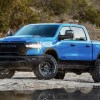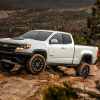
GM’s Autonomous Truck Could Aid in Disaster Relief
Over the past few decades, vehicles have been completely revolutionized. Not only are the cars we drive more technologically advanced and environmentally friendly, but every other type of wheel is advancing as well. General Motors’ has been working on fuel cell technology for years, creating an autonomous, hydrogen fuel cell truck that could change the game for commercial trucking, military transportation, and disaster relief.
A vehicle that could provide water and supplies during an emergency, safely transport soldiers, generate power in a disaster, transport medical care, and more could have potential in areas all over the world. But how did GM build this zero-emission, autonomous monster? Here’s everything you need to know about the world-changing SURUS.
How a new autonomous GM truck could help the world
SURUS, a Silent Utility Rover Universal Superstructure, was also named after the war elephant used by Hannibal to defeat the Roman Empire, according to Defense News. Just like Hannibal’s elephant, SURUS will be able to carry anyone and anything.
Back in 2017, General Motors planned to display this brand-new vehicle to the United States Army, according to GM’s Newsroom. SURUS is the impressive creation behind GM’s aim “to solve some of the toughest transportation challenges created by natural disasters, complex logistics environments, and global conflicts.”
SURUS could completely revolutionize the way the world utilizes vehicles. It was built to be fully autonomous, with an overall design that would make it both high-performing and zero-emission. The idea behind SURUS would alleviate logistical burdens in the military, public, and commercial industries, as well as “reduce human exposure to harm.”
GM designed the large and impressive SURUS to be fully off-road capable, with other benefits including quiet operation, field configuration, flexible cargo delivery systems, water generation, exportable power generation, and super-fast refueling times.
Is this just the beginning?
But SURUS is just the beginning. GM plans to use SURUS “to form a foundation for a family” of vehicles that would use the same, single propulsion system. While these fleets would be initially geared toward solving commercial solutions, the SURUS family could also be adapted to suit military environments, disaster relief, and more.
With “highly mobile autonomous capability and agility in unpredictable terrain,” SURUS and its future fleet could provide solutions to a variety of problems and reduce the manpower needed to do it.
Because the hydrogen fuel cell-based SURUS only creates water, GM claims that it will be able to provide electricity and power in emergency situations, create potable water, and provide ample cargo space for supplies, etc. SURUS could also operate autonomously in a military convoy, reducing risk to military personnel. The possibilities of the SURUS are endless.
The SURUS truck: how it works
Engineers and scientists at GM have been researching and using fuel cell technology for years. The SURUS vehicle uses a Hydrotec fuel cell system designed by GM and it is used to provide electricity for electric motors at each of the SURUS truck‘s axles, according to Digital Trends.
Using this technology, high-voltage batteries, and knowledge of electric drive systems, the SURUS can maintain its enormous size and large payload capacity, while also being able to operate over extreme distances without producing emissions.
In order to become a massive, autonomous truck, the platform uses two advanced electric drive units, a lithium-ion battery system, GM’s Gen 2 fuel cell system, four-wheel steering, a hydrogen storage system, and advanced propulsion power electronics. It all sits on GM truck chassis components, with an advanced, industry-leading suspension. SURUS is also built with a specialized, hydrogen storage system that makes it capable of traveling for more than 400 miles at a time.


